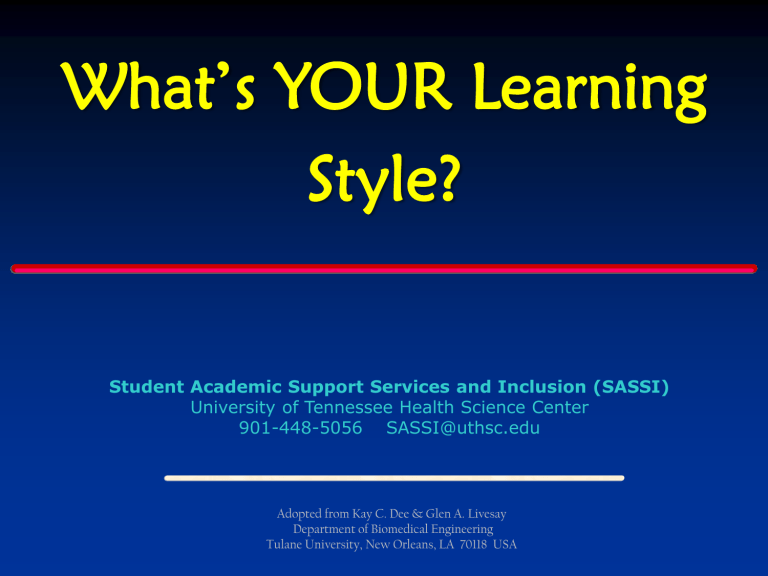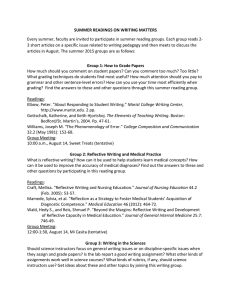What’s YOUR Learning Style? Student Academic Support Services and Inclusion (SASSI)

What’s YOUR Learning
Style?
Student Academic Support Services and Inclusion (SASSI)
University of Tennessee Health Science Center
901-448-5056 SASSI@uthsc.edu
Adopted from Kay C. Dee & Glen A. Livesay
Department of Biomedical Engineering
Tulane University, New Orleans, LA 70118 USA
Example I
Raw Score Percentile_____Did Not Finish
62 35 10 Vocabulary
Comprehension 54 23 16
Reading Rate 247 52
Example II
Vocabulary
Comprehension
Reading Rate
Raw Score Percentile___Did Not Finish
67
56
261
50
26
61
Vocabulary
Comprehension
Reading Rate
Example III
Raw Score Percentile___Did Not Finish
63 39
66
247
54
52
Index of Learning Styles: Overview
Active Reflective Sensing Intuitive
Visual Verbal Sequential Global
ILS Domains
Active Reflective
• Process information while doing something active
• Processes information introspectively
• Group work • Likes independent work
• May start tasks prematurely
• May never get around to starting tasks
“Let’s just try it out.”
“Let’s make sure we’ve thought this through.”
Catering to YOUR Learning Style
Active
•
Practice Questions
•
Brain Unload
•
Note Cards
•
Quizzes following lecture
•
Discussion/Study Groups
•
Talking aloud
•
Peer Tutoring
Reflective
• Develop Own Questions
•
Put lecture notes in own words and/or divide into smaller sections
• Ask, “What did I learn or remember from lecture or lab?”
•
Study alone and then with group or tutor
ILS Domains
Sensing Intuitive
• Focuses on what is seen, heard, touched, etc.
• Prefers concrete information: facts and data
• Focuses on ideas, possibilities, theories
• Prefers abstract information: theory and models
“How does this class relate to the real world?”
“All we did were plug-andchug assignments.”
Cater to YOUR Learning Style
Sensing
•
List topics from upcoming lecture/readings
•
List facts related to topics
•
Application of lecture/reading topics
•
“Why and How will material be useful?”
Intuitive
•
Preview with questions prior to lecture
•
Identify relationships between lecture and/or reading material
•
Use maps (concept maps) linking facts and topics
•
“What would happen if?”
•
FOCUS ON MEANING
ILS Domains
Visual
• Pictures
• Diagrams
• Flow charts
• Mapping
“Show me the systems you’re talking about.”
Verbal
• Spoken words
• Written words
• Formulas/Numbers
“Explain what’s going on inside the systems.”
Cater to YOUR Learning Style
Visual
•
Diagrams, pictures, charts
•
Concept maps, graphs
•
Visual memory joggers
Verbal
• Print lecture notes, outline, objectives, etc.
•
Record lectures
(professor approval) and/or readings
•
Listen to lectures/readings in car
•
Record yourself and listen in car
(pause to allow time to process/answer)
•
Note Cards; Post-It Notes
ILS Domains
Sequential
• Details, steps, process, etc.
• Steady progress
• Good at detailed analysis
“I need to focus on one part of the project and get it done - then I can move onward.”
Global
• Big picture
• Starts slow and then makes conceptual leaps
• Good at creative synthesis
“I need to see how this all fits together before I can start the project.”
Cater to YOUR Learning Style
Sequential
•
List topics to be covered
•
How did you get to big picture?
•
Make checklist for important details for each topic or lecture
•
Know steps and/or process involved
Global
• Beginning of each lecture make outline; show relationships between details and “big picture”
•
“What do you know/think about when you read/hear ____”
•
Give purpose of the lecture/reading
• Connect new material with old materials and knowledge base
This doesn’t mean we “
put people in boxes
.”
Everyone learns both actively and reflectively, both visually and verbally, etc. However, most people have a stronger preference for one. Try to balance the two modalities to enhance the learning process.


